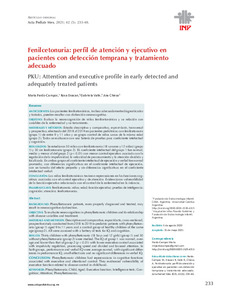Please use this identifier to cite or link to this item:
https://repositorio.uca.edu.ar/handle/123456789/12492| Título: | Fenilcetonuria: perfil de atención y ejecutivo en pacientes con detección temprana y tratamiento adecuado PKU: Attention and executive profile in early detected and adequately treated patients |
Autor: | Pardo Campos, María L. Enacan, Rosa Valle, Gabriela Chiesa, Ana |
Palabras clave: | FENILCETONURIA; NIÑOS; EDAD; COGNICION; ATENCION; TEST DE INTELIGENCIA | Fecha de publicación: | 2021 | Editorial: | Edición y Farmacia S.A. de C.V. | Cita: | Pardo Campos, María L. et al. Fenilcetonuria: perfil de atención y ejecutivo en pacientes con detección temprana y tratamiento adecuado [en línea]. Acta pediátrica de México. 2021, 42 (5). Disponible en: https://repositorio.uca.edu.ar/handle/123456789/12492 | Resumen: | Resumen:
ANTECEDENTES: Los pacientes fenilcetonúricos, incluso adecuadamente diagnosticados
y tratados, pueden resultar con disfunción neurocognitiva.
OBJETIVO: Evaluar la neurocognición de niños fenilcetonúricos y su relación con
variables de la enfermedad y su tratamiento.
MATERIALES Y MÉTODOS: Estudio descriptivo y comparativo, expost-facto, transversal
y prospectivo, efectuado del 2018 al 2019 en pacientes pediátricos con fenilcetonuria
(grupo 1) de entre 9 y 11 años y un grupo control de niños sanos de la misma edad
(grupo 2). Todos se evaluaron con una batería de pruebas para coeficiente intelectual
y cognición.
RESULTADOS: Se estudiaron 30 niños con fenilcetonuria (18 varones y 12 niñas) (grupo
1) y 30 sin fenilcetonuria (grupo 2). EL coeficiente intelectual del grupo 1 fue normal,
medio y menor al del grupo 2 (p < 0.01) con menor control ejecutivo asociado con la
regulación de la impulsividad, la velocidad de procesamiento y la atención dividida y
focalizada. En ambos grupos el coeficiente intelectual de ejecución y verbal fue normal
promedio, con diferencias significativas en el coeficiente intelectual de ejecución,
con un tamaño del efecto pequeño y sin diferencias significativas en el coeficiente
intelectual verbal.
CONCLUSIÓN: Los niños fenilcetonúricos tuvieron repercusiones en las funciones cognitivas asociadas con el control ejecutivo y de atención. Evidenciaron vulnerabilidad
de la función ejecutiva relacionada con el control de la enfermedad en la infancia. Abstract: BACKGROUND: Phenylketonuric patients, even properly diagnosed and treated, may result in neurocognitive dysfunction. OBJECTIVE: To evaluate neurocognition in phenylketonuric children and its relationship with disease variables and treatment. MATERIALS AND METHODS: Descriptive and comparative, expost-facto, cross-sectional, prospective study conducted from 2018 to 2019 in pediatric patients with phenylketonuria (group 1) aged 9 to 11 years and a control group of healthy children of the same age (group 2). All were assessed with a battery of tests for IQ and cognition. RESULTS: Thirty children with phenylketonuria (18 boys and 12 girls) (group 1) and 30 without phenylketonuria (group 2) were studied. The IQ of group 1 was normal, average and lower than that of group 2 (p < 0.01) with lower executive control associated with impulsivity regulation, processing speed and divided and focused attention. In both groups, performance and verbal IQ were average normal, with significant differences in performance IQ, small effect size and no significant differences in verbal IQ. CONCLUSION: Phenylketonuric children had repercussions in cognitive functions associated with executive and attentional control. They evidenced vulnerability of executive function related to disease control in childhood. |
URI: | https://repositorio.uca.edu.ar/handle/123456789/12492 | ISSN: | 2395-8235 | Disciplina: | PSICOLOGIA | Derechos: | Acceso abierto | Fuente: | Acta pediátrica de México Vol.42, No.5, 2021 |
| Appears in Collections: | Artículos |
Files in This Item:
| File | Description | Size | Format | |
|---|---|---|---|---|
| fenilcetonuria-perfil-atencion.pdf | 349,82 kB | Adobe PDF |  View/Open |
Page view(s)
292
checked on Apr 27, 2024
Download(s)
317
checked on Apr 27, 2024
Google ScholarTM
Check
This item is licensed under a Creative Commons License

